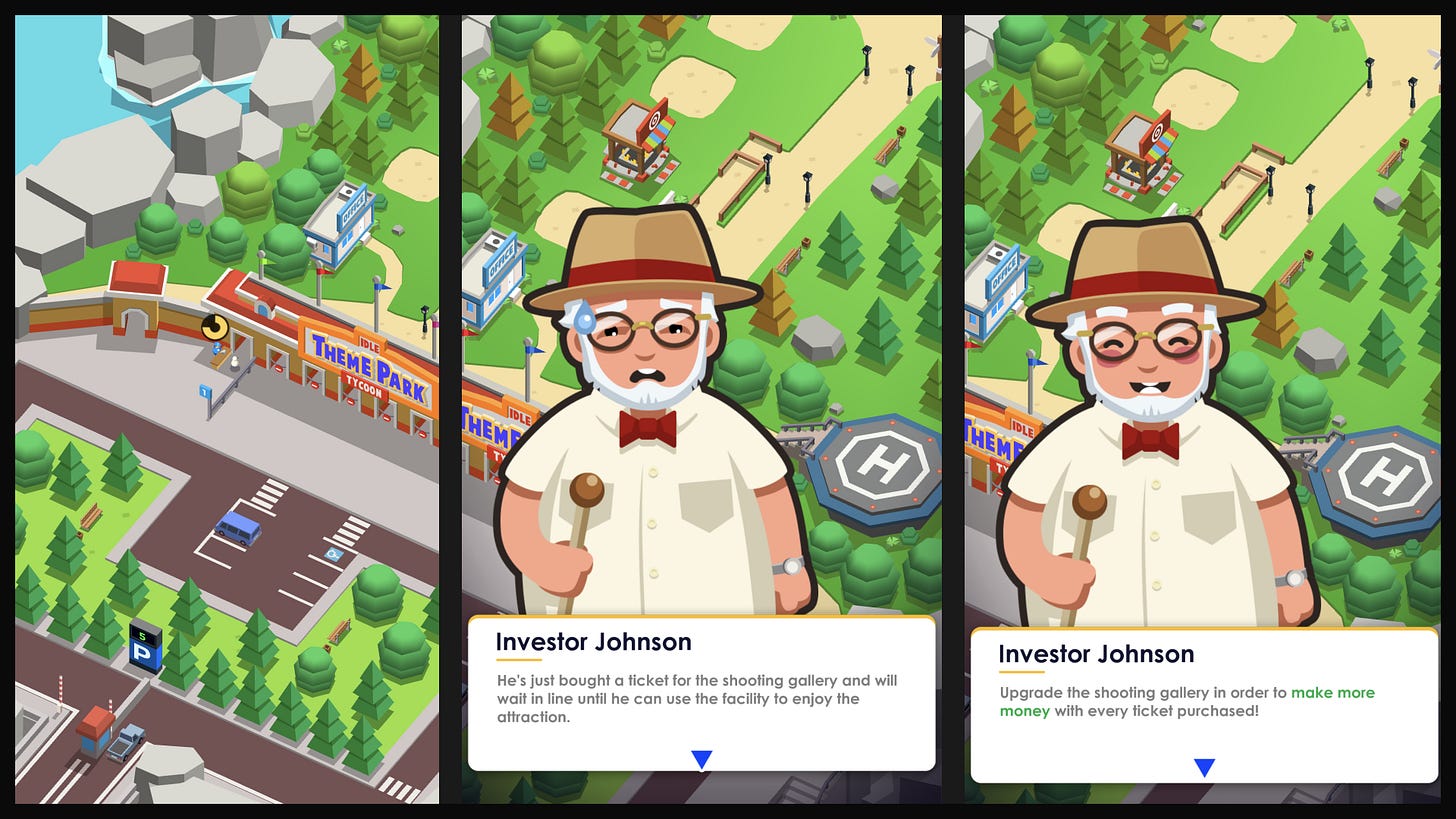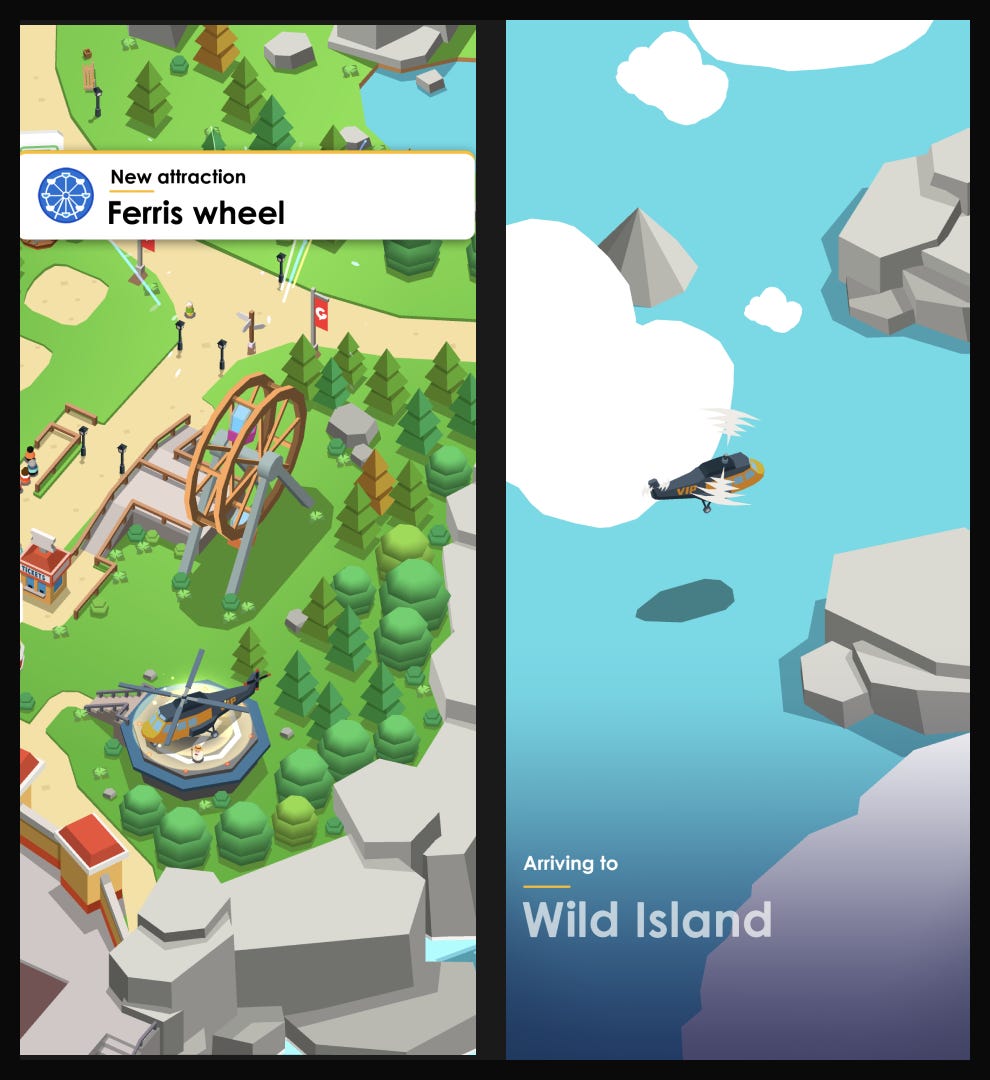900 seconds with Idle Theme Park Tycoon - Game Design Lessons and Challenges
6 Game Design lessons from 15 minutes of gameplay
I have literally no clue how this game made it to my smartphone. I think it was idling (pun intended) in my Games Folder for a while. Quick online browsing revealed that Idle Theme Park Tycoon (ITPT) is currently charting at 18th place in our local AppStore, and Codigames managed to amass a couple million downloads and hundreds of thousands of reviews too. Another big boy title in front of us! THEME PARK is another nostalgia topic for gamers of my generation, so let’s cover it. Shall we?
WHY 900 SECONDS?
Anytime I try a new game, I’m a bit worried for myself. If the game is well designed, I can easily spend a lot of time even in the first session.
To keep myself in check, I decided to put a strict timer for just 15 minutes and turn it into an exploration of game design.
The original question was: Can you learn anything insightful by just playing 15 minutes? Always.
So the new question is: What can you learn in just 15 minutes?
Let’s find out today with Idle Theme Park Tycoon. (You can Download the game at AppStore / Google Play )
GAME DESIGN LESSONS
Reminder: Game design (GD) lessons follow the principle of the Design Breadcrumbs newsletter which is to provide easy-to-digest insights.
1. First minute of gameplay focused on core
Straight from the get-go, I got to meet friendly-looking Investor Johnson. His position (Investor) helped me to understand his role and that he is here to help me with the guidance.
Then the focus immediately shifted to our first incoming visitor and the “visitor’s journey” in the park. I was not able to interact with the game for the first minute, but it helped me to understand the core principle of the Amusement Park and how it operates. The visitor arrives, parks the car, buys the ticket, and enjoys the park. All of these actions generate money.

Lesson: Finding a clear form on how to present the core loop in your game is essential. Only then you can start implementing the next, more complex features. You probably won’t find the winning solution on the first try, so keep looking for the “winner!”.
(Johnson is an investor, yet he didn’t mention anything about the shareholders wanting to see their profits. Strange!)
2. Real life activities turned into mechanics
The game uses a lot of real-world elements and activities, so it is very simple to understand the fundamentals and how I earn money. Parking, Tickets, Attractions, Fast Food, etc. All of these activities are there to make money and it is not as difficult to understand it as compared to other game genres (such as sci-fi).
This is one of the reasons why Civilization: Beyond Earth is not as popular as the other Civilization games. Simply, building a fictional world, with fictional materials and systems is much more laborious to make it work. Real World saves you a lot of time and effort, because “tutorial” happened outside of your game.

Lesson: Using themes from the real world is super friendly, so it requires less developer effort to explain the concept of the game. It especially helps in the hybrid-casual genre, where you are aiming for a broader audience.
3. Clear introduction of new simple in-game mechanics
Anytime I reached a new attraction, there was a dedicated sequence to highlight this event. This helped me to understand better what is happening in the park, sparked my curiosity about what to expect next and it also improved my sense of progression in the game. Sure, such experience is basically impossible to measure and validate with strict performance A/B tests, but there is a reason why design distinguishes between qualitative and quantitative data.
Lesson: Putting some extra love to highlight the important milestones in the game never hurts.
Reminder: Qualitative and quantitative data are not here to compete against each other, instead they are here to help each other.
4. Not so clear introduction of more advanced in-game mechanics
Not so clear introduction of more advanced mechanics. As my gameplay progressed, so did the complexity of the game. Even though I would say that Idle Theme Park Tycoon manages to keep things simple, some of the later features were not introduced with such love as in the tutorial.

Marketing → It was up and running, but it did not explain how the overall income was affected
Boosters → Just by looking at the visual hierarchy of UI, the boosters have a lot of presence. Yet, the introduction was very subtle and there were no support actions to teach me about this mechanic (I found them after 14 minutes of gameplay)
Lesson: Don’t forget about the ways you introduce the later in-game mechanics. Especially with more advanced features, it is probably not enough to show just one tutorial bubble and consider it as “explained”.
GD Challenge: Anytime you design a new feature, ask yourself a question: Am I just showing this one time or am I actually teaching the player how to use it and reinforce this behavior by repeating the action?”
5. User interface seems messy at first
(And it doesn’t get better over time)
If I had to use one word from my experience interacting with the UI in this game, it would be “FRICTION”.
Anytime I was trying to open a mission screen, I struggled to find it. The icon was subtle. There were also many other - not so important - elements competing for my attention. The visual hierarchy overhaul combined with a new set of icons could help

Lesson: The common struggle of games is to develop a coherent functional User Interface that is easy to use. This struggle happens because of the nature of the game design itself. As a game designer, you are often designing new, sometimes never seen before, game mechanics with your own complex set of rules. Such systems are then usually very difficult to put into user interfaces.
Challenge: In the early stages of ideating new features, ask yourself a question: “OK, how do I communicate this idea to a player? (or user) If you find yourself struggling to come up with a simple solution, it might have become too complicated and you need to get back to the ideation phase.
Note: In the past, I wrote the article Visual Hierarchy in design. You can find it here on Design Breadcrumbs.
6. VideoAd rewards as a progression boost
VideoAds are one of the monetization strategies in free-to-play games. It is not uncommon to see projects where the majority of revenues come from this source. Now that we know, that VideoAds are actually an ESSENTIAL monetization method in free-to-play gaming, we need to be savvy and smart with them.
One of the “masterclasses” in VideoAds implementation was discussed in the My Perfect Hotel article. Idle Theme Park Tycoon offered many similar VideoAds placements. However the execution is different and quite often they didn’t feel as a great deal to me, so I often skipped these ads.

Lesson: When you are designing the reward for the player and you are trying to balance it, you can convert these in-game currencies into the currency of TIME. Anytime the player watches the ad, he has “to pay” with 30 to 60 seconds of his game time. If the reward you offer, gives the player progress equivalent to one minute of gameplay, then it is probably not a good deal.
I know. You might think that these are basics, right? Everybody should know that. Well, it happens to the best of us and fundamentals need to be mastered.
Wrap Up
Yup. Once again I played this game much longer than I originally intended, but my Park was just never finished and there was always that “one more update” within reach.
Lesson: “One more hook” is a real-world phenomenon that has been popularised by the Civilization series and their infamous “ONE MORE TURN”. There is even an entry in the urban dictionary and many many gaming reddit threads.
Confession: During my University years, in the mid-summer evening I started a new session at Civilization 4. At 2AM in the morning I wanted to stop, yet somehow with the “ONE MORE TURN” I ended up playing till 6AM ( ͡° ͜ʖ ͡°)
If you liked this article, don’t forget to like, comment and subscribe below, so you won’t miss out on the future posts.




